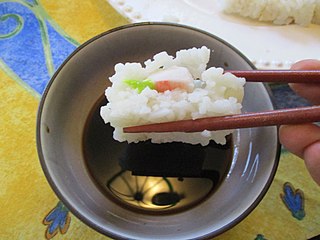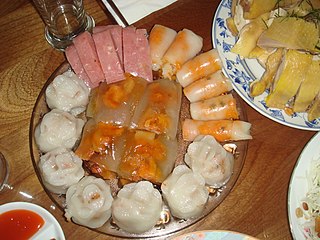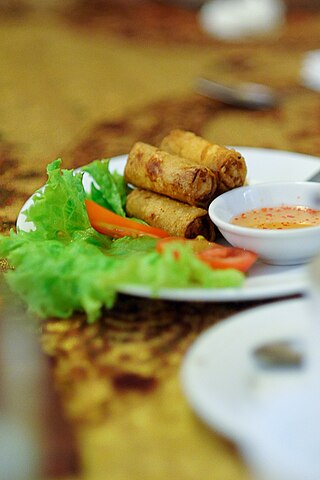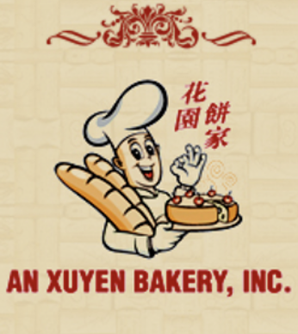
Cajun cuisine is a style of cooking developed by the Cajun–Acadians who were deported from Acadia to Louisiana during the 18th century and who incorporated West African, French and Spanish cooking techniques into their original cuisine.

Vietnamese cuisine encompasses the foods and beverages originated from Vietnam. Meals feature a combination of five fundamental tastes : sweet, salty, bitter, sour, and spicy. The distinctive nature of each dish reflects one or more elements, which are also based around a five-pronged philosophy. Vietnamese recipes use ingredients like lemongrass, ginger, mint, Vietnamese mint, long coriander, Saigon cinnamon, bird's eye chili, lime, and Thai basil leaves. Traditional Vietnamese cooking has often been characterised as using fresh ingredients, not using much dairy or oil, having interesting textures, and making use of herbs and vegetables. The cuisine is also low in sugar and is almost always naturally gluten-free, as many of the dishes are rice-based instead of wheat-based, made with rice noodles, papers and flour.

Louisiana Creole cuisine is a style of cooking originating in Louisiana, United States, which blends West African, French, Spanish, and Native American influences, as well as influences from the general cuisine of the Southern United States.

A po' boy is a sandwich originally from Louisiana. It traditionally consists of meat, which is usually roast beef, ham, or fried seafood such as shrimp, crawfish, fish, oysters, or crab. The meat is served in New Orleans French bread, known for its crisp crust and fluffy center.

In Vietnamese cuisine, bánh mì or banh mi is a short baguette with thin, crisp crust and a soft, airy texture. It is often split lengthwise and filled with meat and savory ingredients like a submarine sandwich and served as a meal, called bánh mì thịt. Plain bánh mì is also eaten as a staple food.

A lobster roll is a dish native to New England and Atlantic Canada. It is made of lobster meat served on a grilled hot dog–style bun. The filling may also contain butter, lemon juice, salt, and black pepper, with variants made in some parts of New England replacing the butter with mayonnaise. Other versions may contain diced celery or scallion. Potato chips or French fries are the typical side dishes.

A dip or dip sauce is a common condiment for many types of food. Dips are used to add flavor or texture to a food, such as pita bread, dumplings, crackers, chopped raw vegetables, fruits, seafood, cubed pieces of meat and cheese, potato chips, tortilla chips, falafel, and sometimes even whole sandwiches in the case of jus. Unlike other sauces, instead of applying the sauce to the food, the food is typically placed or dipped into the sauce.

A hush puppy is a small, savory, deep-fried round ball made from cornmeal-based batter. Hushpuppies are frequently served as a side dish with seafood and other deep-fried foods.

In Vietnamese, the term bánh translates loosely as "cake" or "bread", but refers to a wide variety of prepared foods that can easily be eaten by hands or chopsticks. With the addition of qualifying adjectives, bánh refers to a wide variety of sweet or savory, distinct cakes, buns, pastries, sandwiches, and other food items, which may be cooked by steaming, baking, frying, deep-frying, or boiling. Foods made from wheat flour or rice flour are generally called bánh, but the term may also refer to certain varieties of noodle and fish cake dishes, such as bánh canh and bánh hỏi.

The cuisine of Algeria is influenced by Algeria's interactions and exchanges with other cultures and nations over the centuries. It is based on both land and sea products. Conquests or demographic movement towards the Algerian territory were two of the main factors of exchanges between the different peoples and cultures. The culinary traditions of Algeria, like that of many North African countries, have influences from Amazigh, Andalusian, Arab, Ottoman, Mediterranean, and French cuisines.

Dong Phuong Oriental Bakery is a Vietnamese retail and wholesale bakery, restaurant, and catering business in New Orleans, Louisiana. It is known for supplying the baguette style bread for many of the city's restaurants that offer banh mi or other sandwiches, and has its own popular banh mi counter. The bakery, along with the nearby Mary Queen of Vietnam Catholic Church, were fixtures of the Vietnamese community in New Orleans even before surviving the devastation of Hurricane Katrina. It is located at 14207 Chef Menteur Highway in the "Little Vietnam" section of Eastern New Orleans. It is attached to a sit-down restaurant of the same name that serves a variety of Vietnamese and Chinese dishes, including phở, bún thịt nướng, bún riêu, and bánh hỏi.

The cuisine of New Orleans encompasses common dishes and foods in New Orleans, Louisiana. It is perhaps the most distinctively recognized regional cuisine in the United States. Some of the dishes originated in New Orleans, while others are common and popular in the city and surrounding areas, such as the Mississippi River Delta and southern Louisiana. The cuisine of New Orleans is heavily influenced by Creole cuisine, Cajun cuisine, and soul food. Later on, due to immigration, Italian cuisine and Sicilian cuisine also has some influence on the cuisine of New Orleans. Seafood also plays a prominent part in the cuisine. Dishes invented in New Orleans include po' boy and muffuletta sandwiches, oysters Rockefeller and oysters Bienville, pompano en papillote, and bananas Foster, among others.

Chả giò, or nem rán, also known as fried egg roll, is a popular dish in Vietnamese cuisine and usually served as an appetizer in Europe, North America & Australia, where there are large communities of the Vietnamese diaspora. It is ground meat, usually pork, wrapped in rice paper and deep-fried.

Khao jee pâté, is a Lao baguette-based sandwich, similar to Vietnam's bánh mì and Cambodia's num pang. It is a famous street food found throughout Laos. The baguette or French bread was introduced to Laos when Laos was ruled under French Indochina.

An Xuyên Bakery is a bakery in Portland, Oregon.















